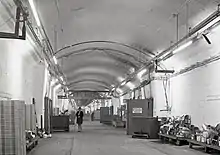RAF Harpur Hill
RAF Harpur Hill was a Royal Air Force base, situated at Harpur Hill near Buxton, Derbyshire in England. The site was operational from 1938 to 1960 and was mainly used as an underground munitions storage facility.[1] It became the largest ammunitions dump in the country across the 500 acres (200 ha) site.[2]
| RAF Harpur Hill | |
|---|---|
| Harpur Hill, Derbyshire Near Buxton in England | |
 RAF Harpur Hill | |
| Coordinates | 53.233°N 1.919°W |
| Type | Royal Air Force station |
| Site information | |
| Owner | Ministry of Defence |
| Operator | Royal Air Force |
| Site history | |
| Built | 1938 |
| In use | 1939–1960 |
| Airfield information | |
| Elevation | 400 metres (1,312 ft) AMSL |
RAF site history
During World War I, the Frith artillery range was located on the site.[3]
From December 1939 to December 1960, the RAF Maintenance Unit 28 was based at Harpur Hill. The RAF used Harpur Hill as an underground munitions store. 11 tunnels were built (concrete galleries covered by waste quarry stones) and dug into the hillside in 1938 by the Air Ministry (at a cost of £6,500,000) to house munitions (ammunition and weapons) and ordnance (bombs and explosives) during World War II. The small entrance leads into one main tunnel, which used to have a railway track running along its length, with three side tunnels branching off on each side. These tunnels are 25 feet (7.6 m) wide, 17 feet (5.2 m) high and over half a mile long. The tunnels were constructed 60 feet (18 m) below ground level to withstand enemy bombing raids. There are four slightly smaller tunnels on a lower level, accessed by lifts. War food rations were also stored within the tunnel system. A UXO (bomb disposal) unit was based at the site.[3][4]
The large bomb store built in 1939 at RAF Llanberis in Wales was modelled on the underground tunnel design at RAF Harpur Hill.[5]
RAF Mountain Rescue Service
The RAF Mountain Rescue Service branch for the Peak District was set up (and formalised in January 1944) within RAF Maintenance Unit 28 at Harpur Hill. The team was led by the site's medical officer Flight Lieutenant (later Air Commodore) Dr.David Crichton and it recovered many wartime aircrew from crashes. The high moors and hills of the Peak District have accounted for over 250 aircraft crashes. On 3 November 1948 the RAF team was called out to locate the US Air Force (USAF) Boeing RB-29A Superfortress which had crashed near Bleaklow moor on the Kinder Scout moorland plateau. All 13 crew perished in the tragedy and the crashed aircraft became known as the Bleaklow Bomber. Much of the wreckage is still visible at the crash site, where a memorial was erected in 1988.[6][7][8]
Later uses

After the RAF left the tunnels, Somerset-based Wrington Vale Nurseries bought the underground tunnel network in 1964 and used it as a mushroom farm for over 10 years. Rubble from the demolition of Buxton’s Empire Hotel was used to fill in the channel of the railway line in the main tunnel. After the tunnels were closed again, they were sold to a group of local businessmen and used as a cold store for cheese; a warehouse was built for dry and bonded wines and spirits. Several local hauliers provided the transport for these goods. One of the hauliers was Lomas Distribution and Christian Salvesen and was a major employer in the area; it later sold the site to French transport company Norbert Dentressangle.[9][10]
The site today
Many of the bunkers can still be seen in the surrounding hillside.[9] The site is now operated by the Health and Safety Executive Laboratory, which has had a presence on the site since 1947, when it was the Safety in Mines Research Establishment (SMRE).[11]
References
- "R.A.F. Maintenance Unit 28 – Harpur Hill". Buxton Civic Association. 16 June 2015. Retrieved 7 November 2020.
- "RAF Harpur Hill – Regiment History, War & Military Records & Archives". www.forces-war-records.co.uk. Retrieved 7 November 2020.
- "Harpur Hill". Buxton Civic Association. 16 June 2015. Retrieved 7 November 2020.
- "Harpur Hill". www.bigginhall.co.uk. Retrieved 7 November 2020.
- "Llanberis Bomb Store – Subterranea Britannica". www.subbrit.org.uk. Retrieved 7 November 2020.
- "RB-29A 44-61999, Higher Shelf Stones, Bleaklow". Peak District Air Accident Research. 8 August 2016. Retrieved 19 June 2020.
- "Superfortress RB-29 44-61999 'Over-Exposed!' air crash site on Bleaklow – photos, history, directions and grid references". aircrashsites.co.uk. 1 June 2013. Retrieved 19 June 2020.
- "RAF Harpur Hill" (PDF). Buxton Mountain Rescue Team. Retrieved 15 November 2020.
- "Harpur Hill – Buxton Online – Peak District". www.buxtononline.net. Retrieved 7 November 2020.
- "Fond memories of Harpur Hill's mushroom farm". www.buxtonadvertiser.co.uk. Retrieved 7 November 2020.
- "HSE: Timeline". www.hse.gov.uk. Retrieved 19 June 2020.